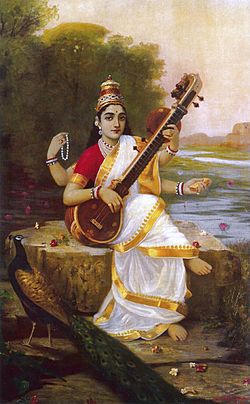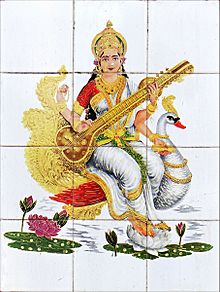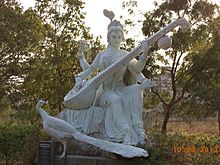Saraswati facts for kids
Quick facts for kids Saraswati |
|
|---|---|
| Personification of the Saraswati River Goddess of Knowledge, Music, Art, Speech |
|
| Member of Tridevi | |

Painting of Saraswati by Raja Ravi Varma
|
|
| Other names | Sharada, Savitri, Brahmani, Bharadi, Vani, Vagdevi |
| Devanagari | सरस्वती |
| Affiliation | Devi, River goddess, Tridevi, Gayatri |
| Abode | Satyaloka, Manidvipa |
| Mantra | ॐ ऐं महासरस्वत्यै नमः, om̐ aim mahāsarasvatyai namaḥ |
| Symbols | The colour white, lotus, Veena, Saraswati river, books |
| Mount | Swan or peacock |
| Festivals | Vasant Panchami and seventh day of Navaratri |
| Personal information | |
| Consort | Brahma |
| Children | Narada |

Saraswati (Sanskrit: सरस्वती, IAST: Sarasvatī) is a very important Hindu goddess. She is known as the goddess of knowledge, music, art, speech, wisdom, and learning. She is one of the three main goddesses, called the Tridevi, along with Lakshmi and Parvati.
The first time Saraswati was mentioned as a goddess was in the ancient Hindu text called the Rigveda. She is usually shown with four arms. In her hands, she holds a book, a string of beads (rosary), a water pot, and a musical instrument called a veena. Each of these items has a special meaning in Hinduism.
Many Hindus celebrate a festival called Vasant Panchami to honor her. This day is also known as Saraswati Puja in many parts of India. On this day, families often help young children learn to write the letters of the alphabet. People who follow the Jain religion in western and central India also respect her. Some Buddhist groups also honor her.
Contents
What Does Her Name Mean?
The name Saraswati comes from two Sanskrit words: saras and vati. Saras (सरस्) means "pooling water" or sometimes "speech." Vati (वती) means "she who possesses." So, Saraswati can mean "she who has ponds, lakes, and pooling water." It can also mean "she who possesses speech." Another way to look at it is from surasa-vati (सरसु+अति), which means "one with plenty of water."
Saraswati has many names in old Hindu stories. Here are some examples:
- Brahmani: This means the power of Brahma.
- Brahmi: The goddess of sciences.
- Bharadi: The goddess of history.
- Vani and Vachi: These names refer to the flow of music, beautiful speech, or speaking well.
- Varnesvari: The goddess of letters (like in an alphabet).
- Kavijihvagravasini: She who lives on the tongue of poets.
- Vidyadatri: The goddess who gives knowledge.
- Veenavadini: The goddess who plays the Veena.
- Pustakadharini: The goddess who carries a book.
- Veenapani: The goddess who holds a veena in her hands.
- Hamsavahini: The goddess who rides on a swan.
- Vagdevi: The goddess of speech.
Other names for Saraswati include Ambika, Bharati, Chandrika, Devi, Gomati, Hamsasana, Saudamini, Shvetambara, Subhadra, Vaishnavi, Vasudha, Vidya, Vidyarupa, and Vindhyavasini.
Some people also explain "Sara" as "Essence" and "Sva" as "Self." In this way, Saraswati's name could mean "She who helps you understand your true self."
How Was Saraswati Born?
There are different stories about how Saraswati was born. One story says she came from the Samudra Manthan. This was a big event where gods (called Devatas) and demons (called Asuras) worked together to churn the ocean. Saraswati was born from the sea and later married Lord Brahma.
Another story says that Brahma created her using his imagination. She was so beautiful that Brahma could not stop looking at her. Brahma has five heads: four facing the main directions and one on top. His heads would turn to look at Saraswati no matter where she went.
What Do Her Symbols Mean?
Goddess Saraswati is often shown as a beautiful woman wearing pure white clothes. She usually sits on a white lotus flower. The lotus stands for light, knowledge, and truth. Her white clothing, flowers, and swan all represent purity and true knowledge.
Her special prayer (dhyana mantra) describes her as white like the moon. She wears white clothes and white jewelry, shining with beauty. She holds a book and a pen, which stand for knowledge.
Saraswati usually has four arms, but sometimes just two. When she has four hands, they represent the four parts of her husband Brahma's mind: manas (mind), buddhi (intellect), citta (imagination), and ahamkāra (self-awareness). Brahma represents ideas, while Saraswati represents making those ideas real.
Her four hands hold items that have special meanings:
- A pustaka (book or script): This symbolizes the Vedas, which are ancient sacred texts. They represent universal, divine, and true knowledge, as well as all kinds of learning.
- A mālā (rosary or garland): This string of crystals represents the power of meditation, looking within yourself, and spirituality.
- A water pot: This pot of water shows the power to tell right from wrong, clean from unclean, and what is important from what is not. In some texts, the water pot stands for soma, a drink that brings freedom and knowledge.
- A veena: This musical instrument is the most famous thing Saraswati holds. It represents all creative arts and sciences. Her holding it shows that knowledge creates harmony. Saraswati is also linked to anurāga, which is the love for and rhythm of music. This represents all feelings expressed through speech or music.
A hamsa (either a swan or a goose) is often seen near her feet. In Hindu mythology, the hamsa is a sacred bird. It is said that if you give it a mix of milk and water, it can drink only the milk. This symbolizes the ability to choose between good and evil, to see what is real beyond outward appearances, and to find what is eternal. Because she is linked with the swan, Saraswati is also called Hamsavāhini. This means "she who has a hamsa as her vehicle." The swan also stands for spiritual perfection and freedom.
Sometimes, a citramekhala (also called mayura, a peacock) is shown next to the goddess. The peacock represents colorful beauty and the joy of dance. It also symbolizes the ability to change negative things into positive ones, like a peacock eating snakes and turning their poison into beautiful feathers.
Festivals
One of the most well-known festivals for Goddess Saraswati is the Hindu festival of Vasant Panchami. It is celebrated on the fifth day of the Hindu month of Magha (month). In India, it is also known as Saraswati Puja and Saraswati Jayanti.
In 2018, the government of Haryana state in India started and supported an annual festival called the National Saraswati Mahotsav. It is named after Saraswati.
Images for kids
-
Images of the goddess Saraswati can be found not only in India but also in Southeast Asia, Indonesia, China, and Japan. In Japan, she is known as Benzaiten (shown here). She is often shown playing a biwa, a musical instrument, which fits her role as a goddess of music, knowledge, and all that flows.
-
Dancing Sarasvati with eight hands is shown in three parts of the Hoysaleswara temple in Halebid, Karnataka (around 1150 CE). One of these is shown above. She is in a classic Indian dance pose. In her eight hands, she holds a pen, a palm leaf book, a musical instrument, and tools for major arts. This shows how artists saw her as the goddess of knowledge and all arts.
-
Saraswati Puja at Baranagore Ramakrishna Mission Ashrama High School, Kolkata, West Bengal.
-
Statues of Chinese Buddhist gods, with Saraswati in the center, at Jade Buddha Temple in Shanghai, China.
See also
 In Spanish: Sarasvati para niños
In Spanish: Sarasvati para niños









